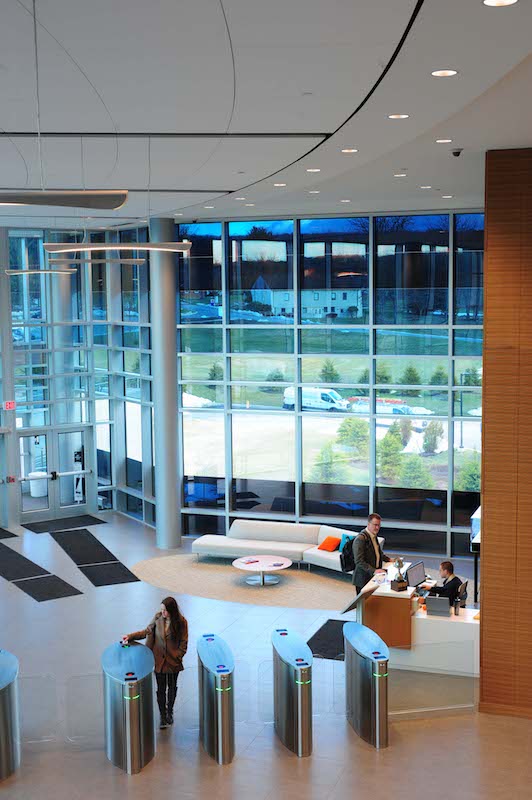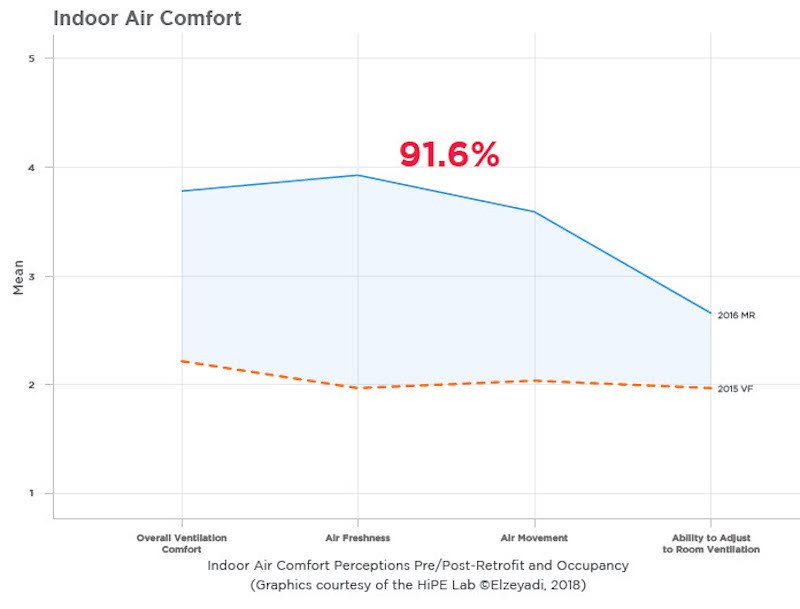Saint Gobain, the giant building materials supplier, has released the results of a three-year-long study that compared occupant comfort for the 800 employees at its old headquarters in Valley Forge, Pa., with the comfort levels for those same employees after they moved into the company’s new 277,000-sf North American headquarters in Malvern, Pa., which opened in October 2015.
That new LEED Platinum-certified building—an adaptive reuse of an office building that entailed 85% renovation and 15% new construction—is a “living laboratory” for Saint Gobain’s current and newly created products. The headquarters also showcases more than 60 innovative technologies.
The four-phase study, buttressed by a 76-question employee survey, found significant improvements in employees’ perceptions about indoor air quality, visual comfort, and acoustic comfort as a result of Saint Gobain’s “multi-comfort design approach” that combines sustainability, aesthetics, and comfort to improve occupant well-being. However, improving thermal comfort proved to be a harder nut to crack.
The study’s results are informing Saint Gobain’s new 30-story worldwide headquarters under construction in Paris.
Saint Gobain “wants to be the leader in habitat” by aggressively promoting its multi-comfort approach, says Stanley Gatland II, Manager of Building Sciences and Comfort for the company’s CertainTeed division. “We want to make occupant outcomes part of the conversation” with customers, adds Lucas Hamilton, CertainTeed’s Manager of Building Science Applications.
Four-step process
To evaluate the impact and efficacy of multi-comfort design elements in the new headquarters, Saint-Gobain partnered with a group of experts led by Dr. Ihab Elzeyadi, Director of the University of Oregon’s High Performance Environments (HiPE) Lab, to conduct an extensive four-phase comparative analysis of Indoor Environmental Quality (IEQ).
In the first phase of the study, a research team inspected the existing unoccupied Malvern facility prior to its adaptive renovation and reuse. In the second phase, the team examined the former Saint-Gobain headquarters in Valley Forge, to establish a benchmark for the performance of the new headquarters. In phase three, the team analyzed the new headquarters following envelope upgrades and interior design retrofits, but prior to occupancy. Finally, the fourth phase of the study assessed the newly completed Malvern headquarters post-occupancy.
Employees were questioned while they still worked at Valley Forge, as well in the fall of 2016 and 2017, after they had settled into the new headquarters. The questionnaires touched on 30 issues pertaining to workspace characteristics, indoor environment quality, comfort of ambient quality, health and well being, and productivity.

Electrochromic SageGlass on the building's southern and western facades contributed to employees' improved visual comfort. Image: Saint Gobain
The visual comfort parameter focused on daylighting and, more specifically, the relative impact of installing Saint Gobain’s SageGlass on the building’s western and southern façades. That electrochromic glazing provides three levels of tinting that are selected automatically in response to system programming and the changing light conditions throughout the day. These are detected by sensors on the roof of the building. The brightness of interior LED luminaires is similarly controlled according to incoming daylight.
In the old headquarters, less than half of the employees had access to daylight; in the new building, 92%. Only 4% of individuals now lack access to outside windows at their workspaces, compared to 23% at the former headquarters.
Unsurprisingly, employees reported a 56.4% overall improvement in visual comfort in the new headquarters, including gains of 30% to 60% in each of the following categories: overall lighting comfort, amount of light for working, glare from electric lights, ability to adjust to electric light, amount of daylight, glare from windows and the ability to adjust window shades.
To evaluate thermal comfort, Saint Gobain invested in significant upgrades to the new building’s core and envelope during renovation, including improved insulation, solar-reflective roofing, high-efficiency glazing, argon-gas-filled insulated glass, aluminum curtain wall systems and high-performance heating and cooling equipment.
The research team calculated thermal comfort conditions in accordance with ANSI/ASHRAE Standard 55-2013 and used electronic sensors over a long period of time to collect data on temperature, relative humidity, air velocity, globe temperature and air movement across various micro-climates in the Malvern facility.
Employees reported only a 4.8% improvement in thermal comfort in the new headquarters compared to the old. At key points during summer months, residents found themselves shifting from overly air-conditioned environments to hot, humid ones over a span of just a few hours.
Hamilton points out that the developer of the new headquarters (which wasn’t Saint Gobain) insisted on repurposing as much of the Malvern office structure as possible, including its mechanicals. Consequently, the HVAC system wasn’t always rightsized for a new headquarters with 116 collaborative spaces. Hamilton believes that thermal comfort results would be “a lot better” in projects that are completely new construction or have more extensive renovations.
“One lesson we learned was to spend more time reviewing whether to retain or replace existing building systems, especially when an extensive renovation will fundamentally change how a building will perform,” Saint Gobain stated in its report on the study.
Better results for acoustics and air quality
The study found much greater success in improving acoustic and indoor air quality. For acoustic comfort, the new headquarters was designed with sound-absorbing surfaces, high-performance interior partitions and exterior facades, isolating vibrating components in the HVAC system, and equipped with white noise machines to mask sound and manage speech intelligibility.
Saint Gobain also mapped the building’s sound absorption, sound levels, and workstation distraction distances to evaluate the effectiveness of its acoustic comfort tactics. It achieved a 42.2% improvement in employee perceptions.

Employees' perceptions of the new headquarters' indoor air quality were significantly higher than how they felt about their old workplace. Image: Saint Gobain
The new building’s air quality was monitored along seven discrete facets of design: outdoor air ventilation, particulate filtration, dehumidification, moisture flow management, air leakage control, Volatile Organic Compound (VOC) control, and contaminant capture.
The design included two wall covering products: one with the ability to trap and neutralize 70% of harmful aldehydes, and another designed with an antimicrobial coating that actively repels and kills fungus and black mold. Drywall tape had mold- and mildew-resistant properties. Backerboard was moisture and mold resistant. Wallboard and ceilings absorbed and converted formaldehyde a safe, inert compound.
The result: a 91.6% improvement in employee perceptions about indoor air quality. “A week after moving into the [Malvern] building, some employees thought we were pumping oxygen into the building,” recalls Hamilton.
Overall, employees reported that levels of visual, acoustical and indoor air quality comfort were 26.3% greater on average at the Malvern facility than at Valley Forge. Additionally, occupants’ satisfaction with indoor environmental quality (a measurement composed of employees’ ratings of temperature, lighting quality, acoustics, air quality, smell, ergonomics and space function) improved by 47.9% in the new space.
Does employee comfort translate to better productivity? Maybe. Saint Gobain compared the performance of its internal sales team in its last week in Valley Forge with its first week in Malvern. The team fielded the same number of calls in both weeks, but qualified leads jumped by 150%, and sales in the latter week were $5.6 million higher.
Related Stories
Office Buildings | May 24, 2023
The future of work: What to expect in 2023
While no one disagrees that the workplace has undergone tectonic changes, it is less clear how to understand these shifts and synthesize them into practical action for the coming year.
Multifamily Housing | May 23, 2023
One out of three office buildings in largest U.S. cities are suitable for residential conversion
Roughly one in three office buildings in the largest U.S. cities are well suited to be converted to multifamily residential properties, according to a study by global real estate firm Avison Young. Some 6,206 buildings across 10 U.S. cities present viable opportunities for conversion to residential use.
Headquarters | May 16, 2023
Workplace HQ for party clothing company Shinesty celebrates its bold, whimsical products
The new Denver headquarters for Shinesty, a party clothing company, was designed to match the brand’s fun image with an iconic array of colors, textures, and prints curated by the design agency, Maximalist. Shinesty’s mission, to challenge the world to live more freely and “take itself less seriously,” is embodied throughout the office interior.
Office Buildings | May 15, 2023
Sixteen-story office tower will use 40% less energy than an average NYC office building
This month marks the completion of a new 16-story office tower that is being promoted as New York City’s most sustainable office structure. That boast is backed by an innovative HVAC system that features geothermal wells, dedicated outdoor air system (DOAS) units, radiant heating and cooling, and a sophisticated control system to ensure that the elements work optimally together.
Headquarters | May 15, 2023
The new definition of Class A property
Dan Cheetham, Managing Director and Founder of FYOOG, believes organizations returning to a "hub and spoke" model could have a profound effect on properties once considered Class B.
Headquarters | May 9, 2023
New Wells Fargo development in Texas will be bank’s first net-positive campus
A new Wells Fargo development in the Dallas metroplex will be the national bank’s first net-positive campus, expected to generate more energy than it uses. The 850,000-sf project on 22 acres will generate power from solar panels and provide electric vehicle charging stations.
Digital Twin | May 8, 2023
What AEC professionals should know about digital twins
A growing number of AEC firms and building owners are finding value in implementing digital twins to unify design, construction, and operational data.
Office Buildings | May 5, 2023
9 workplace design trends for 2023
HOK Director of WorkPlace Kay Sargent and Director of Interiors Tom Polucci discuss the trends shaping office design in 2023.
Office Buildings | May 4, 2023
In Southern California, a former industrial zone continues to revitalize with an award-winning office property
In Culver City, Calif., Del Amo Construction, a construction company based in Southern California, has completed the adaptive reuse of 3516 Schaefer St, a new office property. 3516 Schaefer is located in Culver City’s redeveloped Hayden Tract neighborhood, a former industrial zone that has become a technology and corporate hub.
Mass Timber | May 3, 2023
Gensler-designed mid-rise will be Houston’s first mass timber commercial office building
A Houston project plans to achieve two firsts: the city’s first mass timber commercial office project, and the state of Texas’s first commercial office building targeting net zero energy operational carbon upon completion next year. Framework @ Block 10 is owned and managed by Hicks Ventures, a Houston-based development company.
















